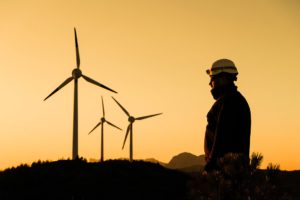“Windmills” have come a long way from the iconic steel towers that sprouted across the prairies in the 1890s. The commercial wind farms that sprung up first in California in the 1980s have spread nearly nationwide. The state of Texas, long known for oil and gas energy, today leads the nation in electricity generated from wind. It’s followed mostly by states in the Great Plains, many of which produce even more energy than California!
The industry is rising quickly – the U.S. government has pegged “wind turbine service technician” as one of the fastest growing jobs.

And those modern, massive turbine blades? They keep getting bigger and bigger – many are longer than a football field. They’ve got to be light enough to move with the wind… plus strong enough to handle years of punishing rotation without twisting or gyrating.
To expand wind power as a low-carbon energy source for our nation, we’re going to need a lot of them.
So, what are these blades typically made of? (Hint: This website is about plastics and sustainability.)
Right, plastics. Actually, mostly composite materials that enmesh plastics (polymers) with other materials (often fibers) to form an advanced matrix. Common fibers include glass to make fiberglass and carbon to make carbon fiber-reinforced plastics.
The fibers themselves aren’t particularly useful on their own. But combining fibers with plastics creates something much tougher than each could be on their own.
It’s sort of like adding rebar (“reinforcing bar”) to concrete, which creates “reinforced concrete.” The combination of glass/carbon fibers and plastics results in materials that are strong, lighter weight, and durable – well-suited for spinning around a rotor and creating low carbon electricity. (And for making a race car or airplane fuselage or prosthetic limb or tennis racket or fishing rod or bicycle frame…)

Lighter weight plastics lower the mass of turbine blades so they can spin faster and generate more energy. To drive down greenhouse gas emissions even further, engineers continue to look for new ways to create lighter, more efficient blades, most of which involve these modern polymer composites. The more efficient the materials, the more efficient our power generation.
Aside from the blades, these wind turbines require lots of parts (as many as 8,000!) and lots of people. According to the U.S. Department of Energy, more than 100,000 people work in wind-related manufacturing facilities across the U.S., making the myriad components that help turbines produce energy more efficiently. Components that often rely on plastics.
This is a practical example of what the scientists and engineers at plastic companies do: create efficient materials for efficient technologies that help drive down greenhouse gas emissions and reduce our environmental footprint.

